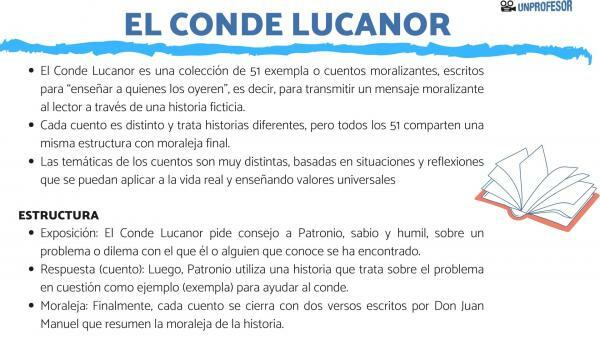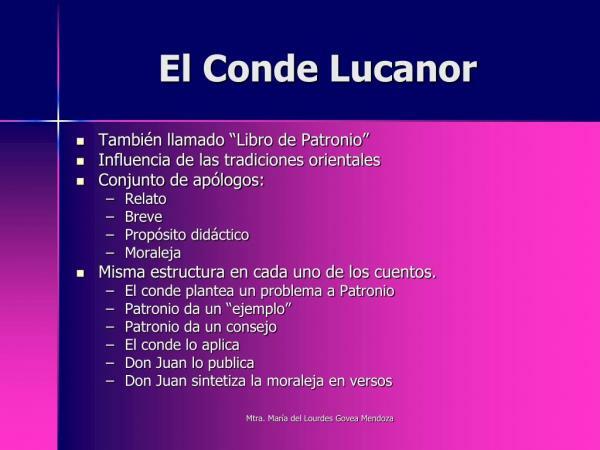SUMMARY of El Conde Lucanor and ANALYSIS of this work

We have all felt to speak of the tales of Arabian Nights oof the stories of Decameron by Boccaccio. With examples of this stature, it is not strange to draw the conclusion that in the Middle Ages, people liked to read - or at least listen to - stories or short stories. But you don't have to leave the country to find examples of similar literature, in the Spanish language.
Count Lucanor, from Don Juan Manuel, is one of the most important works of the Spanish medieval literature. Completed in 1335, the work includes 51 moralizing tales o exempla, with a moral included, that they clearly had a purpose didactics. In this lesson from a TEACHER we will do a short summary from Count Lucanor in general, and we will conclude with a analysis short to reflect on the importance of this work. Prepare your swords and helmets for a visit to the Middle Ages!
Count Lucanoris a collection of 51 exempla or moralizing tales, written to "teach those who hear", that is, to convey a moralizing message to the reader through a fictional story. Each story is different and deals with different stories, but all 51 share
the same structure with a final moral. The entire work of Count Lucanor It has five parts, but it is in this part composed of stories where the center of interest and main study lies.The themes of the stories are very different, based on situations and reflections that can be applied to real life and teaching Universal values: do what you think is right without fear of criticism, in Story II, or avoid fantasies before you can base them on real events, in Story VII, for example. The sources of it are also very varied, including Arabic stories, classical fables, evangelical stories, and historical figures.
In this lesson we are not going to make a summary of each of the stories, but it is important to retain the fundamental ideas of the work, taking into account the two prologues that precede the stories.
Count Lucanor begins not directly with the stories, but with two prologues. In the first, Don Juan Manuel presents himself in the third person as the author, and emphasizes the didactic function of the work. The stories are not only beneficial "for the honor of him, the property and his state", but also relate experiences known to readers, in Spanish (and not in Latin).
In the second prologue, Don Juan Manuel explains that, although everyone is different, “each person learns better what he likes the most”, and comparing his work with a medicine, ensures that his stories - whether the reader understands the moral or not - will serve to teach directly or indirectly through entertainment, and will be of benefit to everybody.
Structure of the tales of Count Lucanor
As Don Juan Manuel himself writes, the stories that follow the prologues imagine “the conversations between a great lord, Count Lucanor and his advisor, named Patronio”. Each story follows the same structure:
- Exposition: Count Lucanor asks the wise and humble Patronio for advice about a problem or dilemma that he or someone he knows has encountered.
- Answer (story): Then, Patronio uses a story that deals with the problem in question as an example (exempla) to help the earl.
- Moral: Finally, each story closes with two verses written by Don Juan Manuel that summarize the moral of the story.

In the next analysis of Count LucanorWe will look at all the didactic forms that Don Juan Manuel's work takes, and how the author's intention is reflected within the text.
Structure of Count Lucanor
One of the crucial elements in reading Count Lucanor is without a doubt his explicit didactic function, that is, of teaching a moral lesson. In a more superficial way, this intention of transmitting a message to educate is visible because the author himself tells us, clearly, in two different prologues that precede the work, and he repeats it to us within the work itself with explicit morals at the end of each story.
Don Juan Manuel's intention is one that the authors of the Enlightenment would also pick up later: that of "Instruct by delighting"In other words, combining teaching with entertainment so that the didactic message reaches the widest possible audience. In the case of Count Lucanor, the moral character of teaching is closely linked also with the religious valuesmedieval. The same author explains it in his prologue, alluding to what part of the benefit of the stories will be that the readers "find the way of salvation", helping to achieve the "salvation of your soul and profit for your body".
But the didactic function is not only reflected in the author's words, but Don Juan Manuel does precisely what he promises, and integrates didacticism in all aspects of Count Lucanor, from the prologue to the final moral, but even in the structure of the work itself.
Thus, the didactic function is also found in the frame structure that surrounds each story. The stories are not presented directly, but rather the author frames them within a fiction where Count Lucanor asks Patronio for advice, and the advice turns out to be helpful in the end. This frame contextualizes the story we are about to read putting him right away through a filter of moral teaching: we know that the story will help the count.
The reader's expectations of the story he will read are to find in it a moral lesson to draw. If there was no frame both at the beginning and at the end of each story, the reader would be free to read in it a lesson to be learned or not, but Through this particular structure, Don Juan Manuel makes sure to fulfill what he promises in the prologue: even those who do not understand the content of the story "they will not be able to avoid that their stories and pleasant style lead them to read the teachings that are intermixed", since the content is subordinated to the expectation of the reader to learn something of the story.
Style at the service of accessibility and didacticism
As corresponds to his didactic intention, Don Juan Manuel's style is in charge of making his stories - and therefore, his lessons - the most. accessible possible. This is achieved not only by writing in Spanish instead of Latin (“For people of little culture”), but also through a clear search for the verisimilitude, which is reflected in some of the stories by the appearance of historical figures, or specific geographical sites. As he puts it in his prologue: "it would be strange if something happened to someone that does not resemble any of those told here."
Don Juan Manuel was a member of the most privileged nobility, grandson of Fernando III and nephew of Alfonso X. Despite his concern for his own social class reflected in some of his other works, Don Juan Manuel wrote Count Lucanor with the clear desire to make the stories accessible to a very wide audience. This will is also demonstrated in his writing style. Simple and understandable, Don Juan Manuel's style sometimes tends to include over-explanations using examples of various concepts.
In the prologue, for example, the author introduces the idea that everyone is different through an example that simplifies the idea using what is called “logic popular ”: Don Juan Manuel goes from describing the most superficial (everyone has different facial features) to transferring it to the interior (as everyone is physically different, the unseen differences - character, personality - are even more varied, and therefore reactions to his work can be just as varied. varied). Explanations through written examples like this or like the comparison of his didacticism with a medicine show how Don Juan Manuel even uses his own writing style to help his accessible and didactic will.
The presence of the author within the work
This style designed with such a specific will and function also results in a curious almost excessive concern with keeping his text as he has written it. In his prologues, especially in the first one, Don Juan Manuel is especially cautious about any misinterpretation that can be made of his work, and blames possible errors in the copies of the work that readers are reading, in case they find something wrong in it: “the copyists, by confusing them, change the meaning of many passages, for which reason the readers then blame the author of the construction site".
This concern for his work as an author is especially interesting given the fact that it is a medieval manuscript, a time when the authorship of literature had not gained modern importance. Its insertion at the end of each story to summarize the moral in two verses is also a way of emphasizing his authorship of the text, and Don Juan Manuel even includes a list of the rest of the works that he has written in the Foreword.


![Characters of TORMENTO de Galdós: main and secondary [Summary!]](/f/0f12255a5f9be9e4cd972267ed19f93f.jpg?width=300&height=200)
![The YES of the GIRLS: main and secondary characters [summary!]](/f/8902bc180eb8bb150dfc99581564752c.jpg?width=300&height=200)
